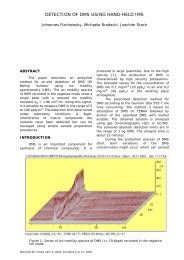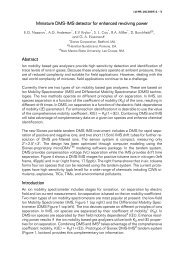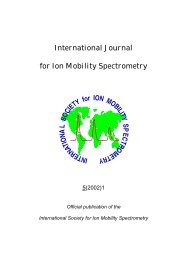columnless gc/ims (ii) - B & S Analytik GmbH
columnless gc/ims (ii) - B & S Analytik GmbH
columnless gc/ims (ii) - B & S Analytik GmbH
You also want an ePaper? Increase the reach of your titles
YUMPU automatically turns print PDFs into web optimized ePapers that Google loves.
IJIMS 5(2002)2,160-174, p. 160COLUMNLESS GC/IMS (II) – A NOVEL ON-LINE SEPARATIONTECHNIQUE FOR IONSCAN ANALYSISDr. Chih-Wu SuU.S. Coast Guard Research & Development Center1082 Shennecossett RoadGroton, CT 06340Phone: (860)441-2703Kim Babcock, Paul deFur, Timothy Noble, and Steve RigdonAnalysis & Technology, Inc.N. Stonington, CT 06359Phone: (860)441-2869[The opinions or assertions contained herein are the private ones of the authors andare not to be construed as official or reflecting the views of the Commandant or theCoast Guard at large. Any instrument, material, or chemical referred to by its brandname does not constitute an endorsement by the authors, the Commandant or the CoastGuard at large.]ABSTRACTThe Ionscan, an ion mobility spectrometry (IMS) instrument manufactured byBarringer Instrument Inc., is currently used by the U.S. Coast Guard boarding offices inconducting illicit drug detection during their vessel search mission. In the process ofcontinuously searching for methods that will provide confirmation of drug detection bythe Ionscan, the U.S. Coast Guard Research and Development Center (USCG R&DC)has observed that drug detection could be improved by placing an extra layer of filterpaper either under or over the swipe sample during analysis. It was proposed that thephenomena responsible this improvement are a temperature ramping effect and achromatographic effect. In order to verify these hypotheses, three mixtures containin<strong>gc</strong>hemicals were analyzed with extra layer(s) of different material placed either under orover the sample filter paper. The chemical contents in those mixtures were withdifferent polarities and their reduced mobility values differed from about 0.6 to 0.028.Analytical data from the Ionscan tests are presented and discussed in this paper. Theseresults support our original hypotheses.
IJIMS 5(2002)2,160-174, p. 164“like dissolves like” principle, the withholding/adsorption power of cellulose on thesedrug standards should be stronger than that of Teflon and thus would increase theirretention times more than Teflon.IMPROVEMENT IN THE SEPARATION OF ECGONINE AND ECGONIDINEMETHYL ESTER (EDME)Ecgonine and EDME are two common impurities in seized, smuggled cocaine. Themain structure of both chemicals is an azabicyclo conformation with a methyl group onnitrogen (see Figure 7). In addition, ecgonine also contains a carboxylic acid group anda hydroxyl group and EDME also contains a cycloalkene group and a carboxylic acidmethyl ester group. Ecgonine is therefore more polar than EDME. The molecularweight of ecgonine and EDME are 185.22 and 181.23 amu, respectively. At roomtemperature, ecgonine is a solid and EDME is a liquid. The reduced mobility values ofecgonine and EDME are 1.548 and 1.505, respectively. Figure 8 shows the Ionscan 3Dplasmagram of these two compounds analyzed without the addition of extra layers ofmaterial. An apparent partial overlapping of peaks is observed. Figure 9 depicts thesame data plotted in an Excel 3D plasmagram and zoomed to the drift time regionaround ecgonine and EDME. Figures 10a to 10c show that increasing the thickness ofthe layer material under the sample filter paper enhanced the separation of these twochemicals. Figures 10d to 10f illustrate that not only is the separation enhanced byincreasing the thickness of the layer material added over the sample filter paper, butalso the prolonged withholding of ecgonine exceeds that observed in Figures 10a to10c. The chromatographic effect of M8A2000 is shown in Figure 11. Although theretention time of both chemicals using Teflon above the sample filter paper was lessthan that on a comparable thickness of cellulose, the peaks were narrower (in retentiontime) when Teflon was used. This further indicates that the chromatographic effect wasthe main cause of the separation when these materials were added over the sample filterpaper.SEPARATION OF BENZOYL ECGONINE AND COCAINEBenzoyl ecgonine is another common impurity in seized, smuggled cocaine. Benzoylecgonine can be a precursor of cocaine or a degradation product of cocaine throughhydrolysis of the carboxylic acid methyl ester group (see Figure 12). The molecularweights of benzoyl ecgonine and cocaine are 289.34 and 303.36 amu, respectively.Both of these chemicals are solid at room temperature. The melting point of benzoylecgonine and cocaine are 86-92 o C and 98 o C 2respectively. The reduced mobilityvalues of benzoyl ecgonine and cocaine are 1.188 and 1.160, respectively. Figure 13ashows the 3D plasmagram zoomed to the drift time region of the benzoyl ecgonine andcocaine peaks. Although it was very difficult to visually resolve these two chemicalson Figure 13a, the Excel 3D plasmagram (Figure 13b) confirms that they are barelyseparated along the retention time axis. Such a minor separation still allowed theIonscan software to detect both chemicals and no false identification occurred whenthey were individually analyzed. Figures 14a and 14b show how the addition of one ortwo layers under the sample filter paper affects the separation of benzoyl ecgonine andcocaine. Because the addition of more layers of material under the sample filter paperincreased the retention times of both chemicals in a similar fashion, there is noimprovement in their separation. Figures 14c and 14d show a substantial improvementin the separation of these two chemicals when extra layer(s) of material are added overthe sample filter paper. The retention times of both chemicals were increaseddramatically along with a broadening in their peak shape. Although the thickness of
IJIMS 5(2002)2,160-174, p. 165M8A2000 Teflon was greater than 2 layers of S&S filter paper, Figure 14e shows thatthe retention times of both chemicals were shorter and the peak shapes were sharperthan those in Figure 14d. This again indicates that the chromatographic effect was themain factor contributing to their separation when extra layer(s) of material were addedover the sample filter paper.CONCLUSIONSThe improvement in peak detection quality during Ionscan analysis either bytemperature ramping in the desorber region or by the chromatographic effect has beendemonstrated with three examples encompassing chemicals with different polarities.Temperature ramping in the desorber region and the chromatographic effect wereachieved by adding extra layer(s) of material under or over the sample filter paper,respectively. These methods were fast and simple to apply without any hardware orsoftware modification to the existing Ionscan. The only change was to extend thedesorption time to 15 or 20 seconds in order to collect data for high molecular weightcompounds with long retention times such as cocaine and heroin. Modification to thelayer materials such as deactivation of the surface of the material or by changing thesurface of materials by applying coating chemicals will be studied in the future todetermine their effect on the separation of chemicals with similar polarity.REFERENCES1. Su, C., Rigdon, S., Babcock, K., Noble, T., and deFur, P., “Columnless GC/IMS (I)– A Study of The Variation in The Thermal Desorption Profiles of Three Models ofIonscan IMS Instrument.” Proceedings of Eighth Int. Conference on Ion MobilitySpectrometry, Buxton, UK, August 1999, in press.2. The Merck Index, Ninth Edition, Merck & Co., Inc., Rahway, NJ, 1976.
IJIMS 5(2002)2,160-174, p. 166Table 1. Average Retention Time and Standard Deviation of Five ReplicateAnalyses of Methamphetamine, Cocaine and Heroin with DifferentMaterials Added Under the Sample Filter PaperLayer(s) ofMaterialThickness( µm )Methamphetamine Cocaine Heroin( sec ) ( sec ) ( sec )No S&S paper 0.0 1.9 ± 0.2 2.7 ± 0.2 3.7 ± 0.41 S&S paper 0.2 3.0 ± 0.2 4.3 ± 0.2 5.4 ± 0.32 S&S papers 0.4 3.5 ± 0.4 5.8 ± 0.2 7.5 ± 0.63 S&S papers 0.6 5.1 ± 0.5 7.9 ± 0.5 10.2 ± 0.51 M8A2000 Teflon pad 0.6 4.3 ± 0.4 6.7 ± 0.2 9.9 ± 0.51 Cellulose pad 0.8 5.8 ± 0.6 9.5 ± 0.5 12.9 ± 0.4Table 2. Average Retention Time and Standard Deviation of Five ReplicateAnalyses of Methamphetamine, Cocaine and Heroin with DifferentMaterials Added Over the Sample Filter PaperLayer(s) ofMaterialThickness( µm )Methamphetamine Cocaine Heroin( sec )( sec ) ( sec )No S&S paper 0.0 1.9 ± 0.2 2.7 ± 0.2 3.7 ± 0.41 S&S paper 0.2 3.5 ± 0.5 6.1 ± 0.5 8.1 ± 0.72 S&S papers 0.4 5.8 ± 1.2 10.2 ± 0.9 13.7 ± 0.83 S&S papers 0.6 9.9 ± 1.4 15.6 ± 0.8 20.5 ± 0.81 M8A2000 Teflon Pad 0.6 2.3 ± 0.5 4.2 ± 0.2 6.3 ± 0.21 Cellulose pad 0.8 14.1 ± 0.7 18.7 ± 0.5 22.8 ± 0.7
IJIMS 5(2002)2,160-174, p. 1684a. Without AddingExtra Layer4b. With 1 LayerAdded4c. With 2 LayersAddedMCHMCHMCHSegmentNumberDrift Time Drift Time Drift TimeFigure 4. Top View of Plasmagrams of Methamphetamine (M), Cocaine (C)and Heroin (H) Spotted on Filter Paper With or Without AddingExtra Layer(s) of S&S Filter Paper UnderRetention Time (sec)16.0014.0012.0010.008.006.004.00S&S filterpaper #404M8A2000Teflon PadSKCCellulose PadHeroinCocaineMethamp.2.000.000 0.2 0.4 0.6 0.8 1Thickness of Material (mm)Figure 5. Average Retention Time of Methamphetamine, Cocaine And HeroinVersus The Thickness of Different Materials Added Under theSample Filter Paper
IJIMS 5(2002)2,160-174, p. 169S&S filterpaper #404SKCCellulose pad20.00Retention Time (sec)15.0010.00M8A2000teflon padHeroinCocaineMethamp.Heroin(tef)5.000.000 0.2 0.4 0.6 0.8 1Thickness of Material Over (mm)Figure 6. Average Retention Time of Methamphetamine, Cocaine And HeroinVersus The Thickness of Different Materials Added Over The SampleFilter PaperCH 3NOCHOHCH 3NOCOCH 3HOHHEcgonineEDMEFigure 7. Chemical Structures of Ecgonine and EDME
IJIMS 5(2002)2,160-174, p. 170EcgonineEDMEFigure 8. Ionscan 3D Plasmagram of Ecgonine and EDMERetentionTime (sec.)Drift Time(m sec.)Figure 9. Excel 3D Plasmagram Close-Up of Ecgonine andEDME Peaks from Figure (8)Figure (8)
EcgonineIJIMS 5(2002)2,160-174, p. 171EDME10a. 1 Layer of Filter PaperUnder10d. 1 Layer of FilterPaper Over10b. 2 Layers of FilterPaper Under10e. 2 Layers of FilterPaper Over10c. 1 SKC Cellulose PadUnder10f. 1 SKC Cellulose PadOverFIGURE 10. Close-up of Ecgonine and EDME Peaks in Different LayeringLayering Configurations (Excel 3D Plasmagrams)
IJIMS 5(2002)2,160-174, p. 172Retention TimeDrift TimeFIGURE 11. Close-up of Ecgonine and EDME Peaks with One M8A2000Teflon Pad Over the Sample Filter Paper (Excel 3D Plasmagram)CH 3NOC OHHOHO CCH 3NOC OCH 3HOO CHBenzoyl EcgonineCocaineFigure 12. Chemical Structures of Benzoyl Ecgonine and Cocaine
IJIMS 5(2002)2,160-174, p. 17313a. Close-Up of Ionscan3D Plasmagram13b. Close-Up of Excel3D PlasmagramBenzoyl EcgonineCocaineBenzoyl EcgonineDrift Time (m sec.)Retention Time (sec.)Figure 13. Ionscan Analysis of Benzoyl Ecgonine and Cocaine on Filter PaperWithout the Addition of Extra Layers of Material
14a. 1 Layer of Filter PaperUnderIJIMS 5(2002)2,160-174, p. 17414b. 2 Layers of Filter PaperUnderDrift TimeRetention Time14c. 1 Layer of Filter PaperOver14d. 2 Layers of Filter PaperOver14e. 1 M8A200 TeflonPad OverFIGURE 14. Close-up of Benzoyl Ecgonine and Cocaine Peaks in DifferentLayering Configurations (Excel 3D Plasmagrams)
















